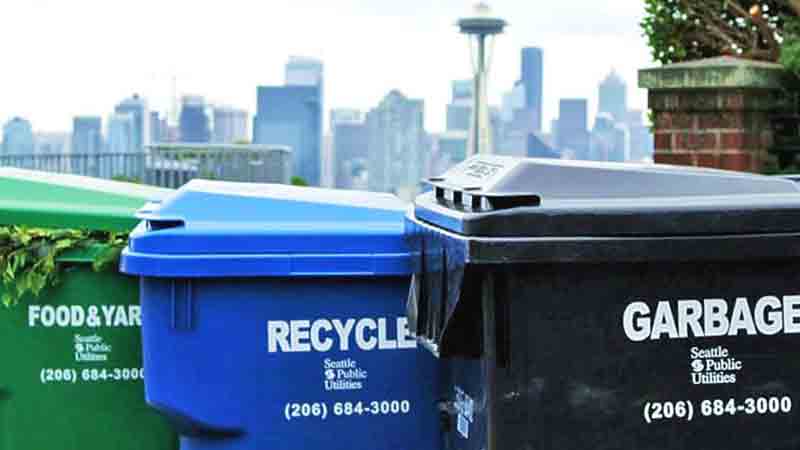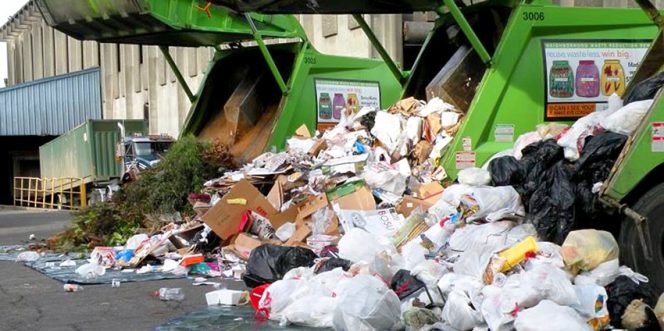Jeffrey Morris
Over the past 40 years, the City of Seattle, Washington, has developed a municipal solid waste (MSW) management system that is agile, cost-effective, and incentivizes diversion. This management system has yielded three long-term successes for residential MSW: steadily decreasing disposal per household; cost savings for ratepayers; and substantial reductions in public health and other environmental pollution impacts.
This article discusses outcomes from Seattle’s innovative residential yard trimmings, food waste and food-soiled paper (“organics”) management programs and regulations that incentivize composting over disposal to landfill. A companion article, discussing outcomes from Seattle’s residential recycling, is appearing in the April print edition of Resource Recycling magazine.
Diversion of organics to composting is environmentally important because applying compost to garden and commercial agriculture soils can reduce reliance on global ecosystems for extracting raw material and energy resources to produce petrochemical fertilizers and pesticides. Compost uses also enhance soil quality and productivity, and increase storage of carbon in soils, further reducing emissions of climate changing greenhouse gases (GHGs).
Seattle Public Utilities’ (SPU) contracts with private sector service providers specify that substantial portions of fees charged by providers are on a per ton handled basis. When these per ton fees are lower for organics collection and composting than for garbage collection and disposal, organics diversion is cost-effective.
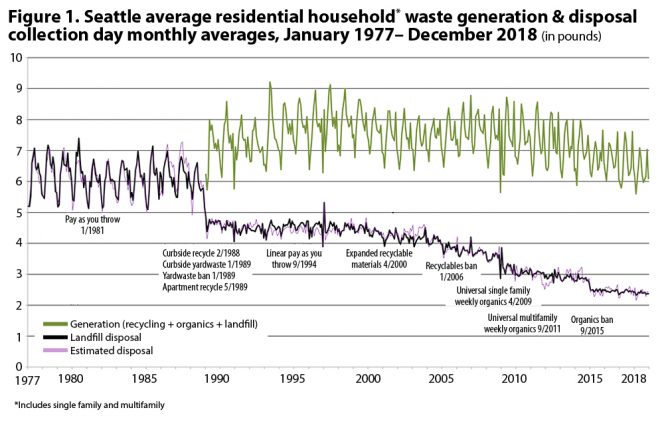 Winning by Reducing Disposal
Winning by Reducing Disposal
Figure 1 shows the success among Seattle’s residential households, including both single-family (SF) and multifamily (MF) residences, in diverting MSW materials from garbage to recyclables or organics collection. Disposal declined from an annual household average of 6.2 pounds (lbs)/collection day in 1977 to 2.4 lbs/collection day by 2018, a decrease of 61%. Furthermore, the graph shows that combined collection day organics, recycling, and garbage set outs by the average household has trended downward since 2010.
The heavy black disposal line in Figure 1 measures average residential household disposal each collection day per month from January 1977 through December 2018. Some of the key programs and regulations implemented by Seattle are noted in Figure 1, highlighting their connection with substantial drops in disposal per household. For example, during 1989, the introduction of curbside collection for yard trimmings from SF households and the ban on putting yard trimmings in the garbage resulted in large drops in household garbage disposal. This also smoothed out seasonal variability of remaining garbage disposal. Over subsequent years, universal SF and MF organics collection subscription mandates, organics collection expansion to include food waste and food-soiled paper that are co-collected with yard trimmings, and a ban on putting these organic materials in the garbage contributed to the continual decline in garbage disposal by the average residential household.
The light purple disposal line in Figure 1 portrays statistical calculations that identify significant factors explaining cycles and trends in residential garbage disposal. Its close match with actual residential disposal indicates that this statistically derived estimate for household disposal accurately identifies and measures those factors that drive residential household behavior. Statistically significant factors identified include programs such as curbside organics collections and on-site composting, regulations such as organics disposal bans, weather and other seasonal influences, and economic variables such as income and garbage collection fees.
Garbage collection fee impacts depend on availability of convenient opportunities for diverting discards to recycling and composting, and the extent to which garbage collection fees increase when a household’s garbage disposal quantities go up. Although introduced in 1981, pay-as-you-throw (PAYT) garbage collection fees did not significantly reduce disposal weights until 1989. At that time households began to have access to curbside recycling at no additional cost and fee-based yard trimmings collection that was lower cost for the typical subscriber and as convenient as curbside garbage collection. Prior to then, households had to haul recyclable materials to privately operated recycling drop-off centers scattered rather sparsely around the city. Households wanting to keep yard trimmings and other organics out of the garbage had to compost those organic materials on-site in their yards.
Winning By Reducing The Garbage Disposal Rate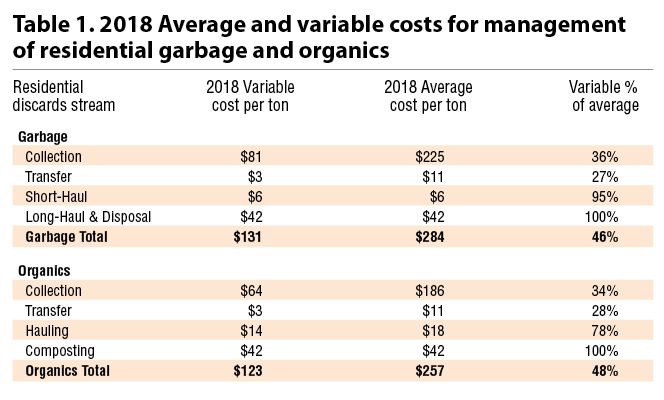
Seattle contracts for collection from residential households; composting of collected organics; rail-haul and landfill disposal of collected garbage; and some hauling from transfer stations of garbage to the rail head and organics to composting facilities. In all these contracts a substantial portion, in some cases 100%, of contracted charges for services are on a per ton handled basis. This means that when organics collection tonnage goes up and garbage collection tonnage goes down, the City pays more for diversion and less for garbage. The difference between these per ton variable costs for garbage and per ton variable costs for organics diversion determines whether diversion of organics from garbage to composting is cost-effective.
Table 1 shows variable and average costs per ton in 2018 for managing collected organics and garbage. Average cost per ton is the sum of the per ton variable cost, plus a per ton share of fixed costs. Costs in Table 1 are disaggregated according to activities involved in handling materials. For collection, the figures represent the weighted average for curbside household and on-site apartment building collections. In 2018, both variable and average costs per ton for organics were lower than garbage.
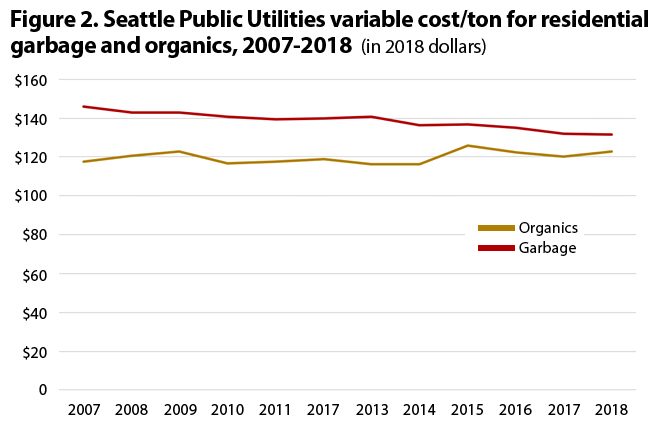 Figure 2 shows the effect of SPU’s specifying that contracts must split costs into fixed and variable portions. The graph shows that residential garbage variable costs per ton have been higher than organics collection and composting variable costs per ton for each year from 2007 through 2018. (As noted earlier, cost details for recycling are covered in a companion article in the April issue of Resource Recycling.) That means that when diversion programs, garbage collection fees, or regulations cause households to move organics out of the garbage cart and into the organics cart, costs for managing MSW go down.
Figure 2 shows the effect of SPU’s specifying that contracts must split costs into fixed and variable portions. The graph shows that residential garbage variable costs per ton have been higher than organics collection and composting variable costs per ton for each year from 2007 through 2018. (As noted earlier, cost details for recycling are covered in a companion article in the April issue of Resource Recycling.) That means that when diversion programs, garbage collection fees, or regulations cause households to move organics out of the garbage cart and into the organics cart, costs for managing MSW go down.
In all 12 years depicted by Figure 2, residential organics diversion was less costly than garbage. Organics diversion cost savings ranged between $9 and $28/ton (2018$), with a weighted average cost savings of $18/ton (2018$) diverted from garbage collection to residential organics collection. During 2007-2018 savings from organics diversion reduced the average residential customer’s solid waste collection bill by $0.89/month (2018$).
Savings from organics diversion declined over the 12 years due to:
- Lower rail haul and landfill disposal variable costs per ton for garbage
- Increased composting costs per ton
Winning By Reducing Environmental Costs
With the 2004 Comprehensive Solid Waste Management Plan Amendment, On the Path to Sustainability, SPU began estimating the external benefits of diversion and their associated savings in environmental costs. (Development of life cycle analysis, life cycle environmental impacts monetization, and references for data and methodologies used in Sound Resource Management Group’s tool Measuring Environmental Benefits Calculator (MEBCalc) for calculating environmental impact costs are discussed in supporting information.) Environmental costs account for damages not covered by prices paid in the marketplace for products and packaging. Such damages include climate change, human health-respiratory illness, human health-toxics illness, human health-carcinogenic illness, waterways eutrophication, acidification, ecosystems toxicity, ozone layer depletion, and ground level smog formation (see MEBCalc).
Garbage disposal life cycle environmental costs avoided by diverting organics to separate collection and composting are higher than organics diversion environmental costs. During 2007-2018, environmental costs for diverted organics materials had they been thrown in the garbage would have averaged $71/ton (2018$). Instead, diverting those materials to separate collection and composting accrued environmental benefits. In fact, collecting and composting organics had a beneficial environmental impact of almost $11/ton (2018$) without even taking avoided garbage disposal environmental impacts into account. This is due to soil carbon storage and above ground biomass enhancement benefits from applying compost to garden and agricultural soils. These climate and other environmental benefits of composting outweigh the environmental impacts of the separate organics collection and composting operations. Environmental damage costs savings from diverting organics averaged $82/ton (2018$) during 2007-2018, an environmental benefit of $3.97/organics subscriber/month throughout the 12 years (constant 2018$).
Organics diversion’s net environmental benefit increased by $10/ton (2018$) between 2007 and 2018. This was mostly the result of increased diversion of food scraps, which have higher landfill climate impacts per ton than yard trimmings. Also, damage costs from current year GHG emissions rise over time as GHG emissions accumulate in the atmosphere. Human health respiratory impact costs also rise as economic activity and population grow, putting more people in emission pathways as the economy expands.
Conclusion
Seattle’s organics management system has provided, and continues to provide, programs, incentives, and regulations that result in long-term declines in disposal, cost savings for ratepayers, and substantial environmental benefits. These successes are all the more remarkable given widespread fears that diversion of recyclables and organics doesn’t make economic sense. The data refute those who will downplay the climate, public health and ecosystem benefits of diverting MSW materials from disposal. Seattle leads the way forward against these fears and doubts by taking the triple-long-view in managing MSW.
Jeffrey Morris, Ph.D., an economist, is with Sound Resource Management Group, Inc.


